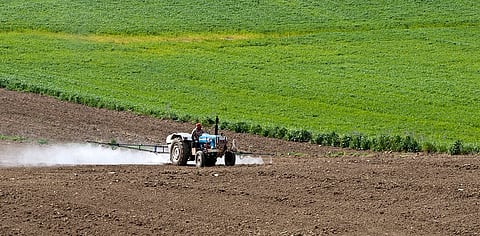

Countries have decided to eliminate chlorpyrifos, a hazardous pesticide, under the Stockholm Convention on Persistent Organic Pollutants (POPs).
However, countries have increased the number of exemptions granted for chlorpyrifos’ use. Initially, there were seven exemptions, which has now risen to 22 over the course of negotiations, raising concerns. Chronic exposure to chlorpyrifos has been linked to adverse effects on neurodevelopment, reduced birth size, lung and prostate cancer.
Delegates from across the world gathered at meetings of the conferences of the Parties to the Basel, Rotterdam and Stockholm (BRS) conventions in Geneva, Switzerland, from April 28 to May 9, 2025. BRS are also multilateral environmental agreements, which share the common objective of protecting human health and the environment from hazardous chemicals and wastes.
The Stockholm Convention lists POPs under three annexes. While Annex A lists chemicals to be eliminated, Annex B and C list chemicals to be restricted, and minimising unintentional production and release of the listed chemical. POPs are chemicals that remain intact for a long time. Widely distributed throughout the environment, they accumulate and magnify in living organisms through the food chain and are toxic to both humans and wildlife.
“We are glad that there finally is a global consensus among parties to the Stockholm Convention to eliminate the deadly insecticide chlorpyrifos by listing in the Annex A with specific exceptions,” A D Dileep Kumar, chief executive, PAN India told Down To Earth (DTE).
The current list of exceptions having 22 uses overall, he added, is really a concern given that chlorpyrifos is able to cause severe irreversible adverse health and environmental effects. “And we all have a responsibility to ensure the harm from chlorpyrifos does not continue,” he stressed.
Countries have decided to allow the use chlorpyrifos — labelled as ‘moderately hazardous’ by the World Health Organization — for crop-pest complexes, control of leaf-cutting ants for agricultural use, control of locusts for agricultural use, control of ticks in cattle and wood preservation against borers and termites in building foundations.
The exemption is allowed for 18 crop-pest complexes including:
Barley (termites)
Cabbage (diamondback moth)
Cacao (cacao-mosquitos and cacao pod borer)
Chickpea (cutworms)
Citrus (scale insects)
Cotton and cotton seed (aphids, carpophagous caterpillars, cutworms, spider mites, cotton leaf roller, whitefly larvae, whitefly adults)
Eggplant (shoot and fruit borer)
Maize (armyworms, lesser cornstalk borer, cutworm, corn earworm, grubs, seedling flies, stem borer, green stink bug)
Onion (root grubs)
Peanut (white grubs)
Pineapple (mealybug, pineapple weevil, glasshouse symphylid)
Rapeseed (crucifer flea beetles, turnip sawflies, common pollen beetles, turnip gall weevils)
Rice (rice planthoppers, rice stemborers, rice leaf rollers)
Sorghum (armyworms, lesser cornstalk borer)
Soya bean (Armyworm, soybean pod borer, soybean seed fly, soybean leaf beetle, tobacco whitefly, soybean aphid, spiraling whitefly, green stink bug, brown stink bug and spider mite)
Sugarcane (termites, beetles, grubs, sugarcane top borer, and sugarcane stem borer)
Teff (termites)
Wheat (termites, corn bugs, wheat chafers, leaf beetles, aphids, and thrips)
The 18 exemptions for crop-pest complexes come after new requests for exemptions were made on May 2. Russia and Costa Rica, for example, requested that chlorpyrifos be allowed for use in rapeseed and pineapple, DTE has learned.
India has approved use of chlorpyrifos for rice, beans, gram, sugarcane, cotton, groundnut, mustard, brinjal, cabbage, onion, apple, ber, citrus, tobacco, termite (wheat, barley, gram, sugarcane) and Bengal gram, according to a 2024 government document.
Delegates took up the chlorpyrifos proposal to be listed under Stockholm following recommendations by the Persistent Organic Pollutants Review Committee (POPRC) — a subsidiary body to the Stockholm Convention established for reviewing chemicals proposed for listing. This was after the body concluded that chlorpyrifos has properties such as persistence in some environments, bioaccumulation and capacity to be long-range transported.
However, POPRC recommended exemptions for plant protection (rice against planthoppers, rice stemborers and rice leaf rollers; scale insects in citrus; underground pest control of grubs on peanuts; underground pest control of sugarcane beetles on sugarcane; control of locusts), control of ticks in cattle as well as wood preservation against borers and termites in building foundations.
“The approach by a few parties requesting more exemptions despite having efficient and viable alternatives and bypassing the scientific assessment and process followed by the POPRC, is more than disappointing,” Kumar highlighted.
He urged parties that have requested exemptions to start implementing non-chemical alternatives and agroecology-based farming practices to eliminate the use of chlorpyrifos as soon as possible. “This will reduce the burden of this poison on the farming community, consumers, children, as well as the environment,” he highlighted
According to the International Institute for Sustainable Development, new exemptions were added to a list much longer than POPRC recommended. It quoted an observer saying, “What is the incentive for industry to go to POPRC when they can just come here and avoid scientific scrutiny?”